Abstract
The transmission of vibrations generated by high-powered machines to the hands can lead to serious health problems and various work-related difficulties for the operators. These issues result in a loss of workforce and increased operational costs due to compensation payments made to affected workers. Exposure to hand–arm vibration can be controlled through the use of vibration damping gloves. In this study, the hand–arm vibration exposure of operators using a jackhammer in three different mines was measured with and without gloves, and the vibration damping ratio of each glove was calculated. One-way analysis of variance was performed to determine the difference between the vibration damping ratios (%) obtained from three separate field measurements of 12 different gloves, and significant differences were detected. In addition, vibration exposure was measured with and without gloves for operators using a vibrating sieve set with standard vibration in a laboratory environment. From both the field and laboratory measurements, the gloves made of chloroprene rubber provide the most effective protection.
1. Introduction
Mechanical vibration refers to the oscillatory motion of an object under the influence of internal or external forces. For various health-related reasons, it is necessary to consider the vibration felt by an individual as a result of contact with a vibrating surface or object. Vibration is transmitted to the human body via the contacted vibrating surface, such as the handle of a machine, the surface of a tool, or the housing of a motorized machine [1]. There are two types of vibration exposure; the first is hand–arm vibration transmitted from hand tools, and the second is whole-body vibration transmitted from the seat or surface of a motorized machine. Hand–arm vibration poses a risk to the health and safety of the individual, potentially causing vascular, bone, joint, nerve, and muscle disorders; whole-body vibration also poses a risk to the health and safety of the individual, especially in the lumbar region, causing trauma to the spine. Numerous occupations involve hand–arm and whole-body vibration, which must be mitigated in workers exposed to vibration for long periods [2,3,4,5].
Health problems, such as numbness in the hands and carpal tunnel syndrome, have been detected in workers exposed to hand–arm vibration in a North China coal mine [6]. Arıtan and Tümer [4] showed that the hand–arm vibration exposure values of the pneumatic hammer operators working in a natural stone quarry were high, emphasizing that the exposure to vibration decreased in operators using anti-vibration gloves, but could not be reduced to the limit value specified in the standard regulations. Arıtan and Memiş [7] measured the hand–arm vibration exposure of construction equipment operators (excavators, trucks, and loaders), observing a 15–21% difference between the vibration exposure levels with and without vibration damping gloves. Nyantumbu et al. [8] found that the prevalence of hand–arm vibration syndrome was associated with the use of hand-held vibrating equipment among workers at a gold mine in South Africa. They found that affected workers may experience tingling, numbness, loss of grip strength, and loss of dexterity, making daily activities difficult and increasing the risk of accidents. They also measured vibration acceleration levels as high as 31 m/s2 in pneumatic hammers and jackhammers. Erol [9] measured the noise and vibration exposure level of machine operators in an underground coal mine, showing that the jackhammer operator was exposed to the most noise and hand–arm vibration among the various machines measured. Oddo et al. [10] developed a suspension arm design model to reduce hand–arm vibration caused by rock drills, such as pneumatic hammers and jackhammers, which are widely used in the mining industry. The hand–arm vibration level reached 25 m/s2 in the frequency range of 6.3–1250 Hz (commonly observed in mining conditions). Nor et al. [11] conducted a study in Malaysia to examine the vibration and noise of five different types of lawn mowers and observed differences in the right and left hands of workers using these machines, specifically, 2.1 to 20.7 m/s2 for the right hand and 2.7 to 29.1 m/s2 for the left hand.
Notably, anti-vibration gloves have been developed to reduce the effects of hand–arm vibration exposure [12,13]. The main difference between ordinary work gloves and anti-vibration gloves is that anti-vibration gloves have a layer of cushioning materials, such as viscoelastic gels, foams, neoprene, air bladders, or air bubbles, included in the palm area of the glove, which can isolate or reduce vibration [14]. The test that must be applied for a glove to be marketed as an anti-vibration glove is specified in the international standard ISO 10819:2013 [15].
In this study, 12 commercially available anti-vibration gloves comprising different materials were examined to determine which gloves minimize the hand–arm vibration exposure of jackhammer operators, and their vibration damping rates (%) were measured in the field. One-way analysis of variance (ANOVA) was performed to determine the differences among the damping ratios obtained from three separate field measurements for the 12 different gloves. Additionally, vibration exposure was measured with and without gloves for operators using a vibrating sieve set with standard vibration in a laboratory environment. The type of glove that provides the most effective protection was determined from both the laboratory and field measurement results.
2. Materials and Methods
At work, people can be exposed to vibration while standing, sitting, lying down, or in some cases, directly in contact with a vibration source. Vibration exposure has become one of the hidden causes of injuries or occupational diseases in many industries. The harmful effects of vibration on health usually become apparent after several years of exposure [2]. Knowing the mechanism of vibration transmission to the human body can help elucidate the body’s biodynamic response to vibration exposure. A better understanding of vibration permeability is also necessary to properly design and implement protective measures to reduce harmful vibrations.
On this basis, in the present study, the hand–arm vibration exposure of jackhammer operators working in 3 different mining operations was investigated. One jackhammer operator was involved in each mine. Hand–arm vibration exposures of jackhammer operators working in three different mines (A, B, and C) were measured three times, both with and without gloves, and the average values were compared. Repeating the measurements three times and taking the average helped reduce deviations caused by individual differences.
Jackhammers (drilling guns equipped with tripods) are typically operated using compressed air. They are employed in horizontal and inclined hole drilling operations in medium-hard and hard rocks and rock drilling operations in mines, railways, dams, and road construction (Figure 1). The same brand and model of jackhammer (TIGER YT 24, Istanbul, Turkey) was used in all three mines. The technical specifications of the jackhammer are provided in the Table 1.
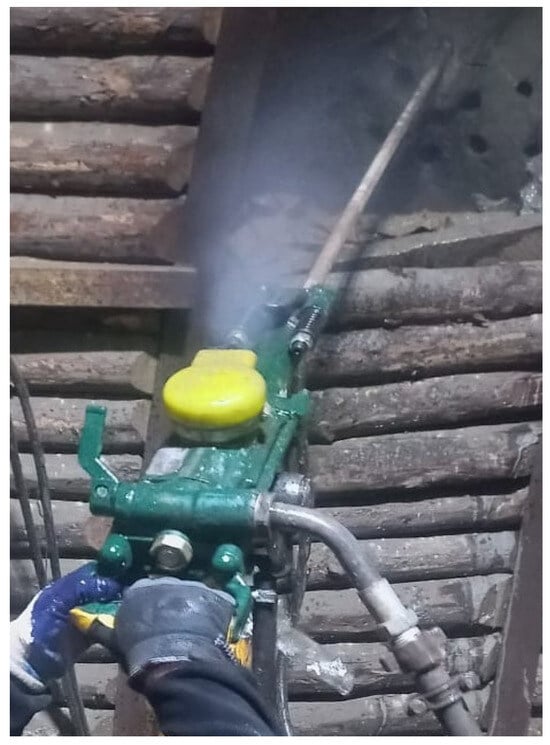
Figure 1.
Jackhammer in operation.

Table 1.
Technical specifications of the jackhammer [16].
In field studies, standardizing biomechanical factors such as grip force and posture of the jackhammer operator is particularly challenging. However, certain measures were implemented to enhance the reliability and comparability of the data.
Prior to the measurements, jackhammer operators were given verbal instructions on how to apply the appropriate grip force. The standard grip and posture were demonstrated through practical examples. Stabilizing the machine in a fixed position and ensuring that the operator maintained a specific posture contributed to preserving a consistent position during measurements. When grip errors were observed during testing, immediate feedback was provided to the operators, allowing for prompt corrections. These measures were implemented to minimize the inherent variability of field conditions and to enhance the reliability of the collected data.
Vibration measurements were performed using an SV 106 hand–arm vibration meter. The analyzer meets the requirements of the TS EN ISO 5349-1 standard [17] and adjusts the Wh filter for hand–arm vibration according to the orientation (Figure 2). The Wh filter is a frequency weighting filter defined in the TS EN ISO 5349-1 standard for evaluating hand–arm vibration (HAV).
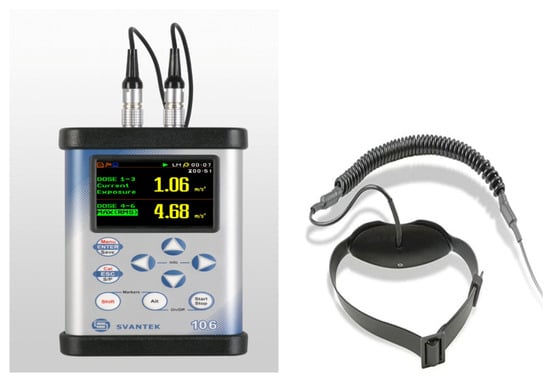
Figure 2.
Hand–arm vibration meter (Poland).
In this study, the accelerometer was fixed to the right-hand palm area, where the jackhammer operators were directly exposed to vibration. After the necessary adjustments were made to the device, the intensity of the vibration was measured for three axes, and the data was recorded on the device. Later, these data were uploaded from the device memory to a computer, and the vibration magnitude (ahv) and vibration exposure value (A(8)) were determined using the device’s SVAN PC ++ software package (https://svantek.com/softwares/svanpc-software/ ((accessed on 9 June 2025).)). The vibration exposure values were then evaluated according to the vibration regulations.
Furthermore, operators were given 12 different anti-vibration gloves composed of different materials, as shown in Table 2. Vibration exposure for operators was also measured while wearing gloves. Finally, the vibration damping rates (%) of the gloves were calculated from the vibration exposure values obtained with and without gloves, and the type of glove that provided the most effective protection was determined.
The total hand–arm vibration exposure is calculated using Equation (1). RMS accelerations (awx, awy, awz) are calculated using the weighting factors specified in TS EN ISO 5349-1 (x-axis = hwx; y-axis = hwy; z-axis = hwz) [17].
ahv: Vibration magnitude (m/s2)
ahwi: Root mean square value of the uniaxial frequency-weighted manually transmitted vibration for process i (m/s2). The x, y, and z suffixes indicate the measurement direction.
Vibration exposure measurements, both with and without gloves, were conducted over a 15 min work period. Subsequently, the exposure values were extrapolated to an 8 h duration. Daily personal vibration exposure (A(8), m/s2) is determined using Equation (2) [18].
T: Total time exposed to vibration (daily)
T0: The reference period is 8 h.


Table 2.
Vibration damping gloves and their properties [19].
Table 2.
Vibration damping gloves and their properties [19].
| No. | Appearance of Gloves | Features of Gloves | |
|---|---|---|---|
| 1 | 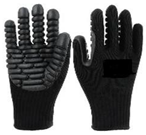 | 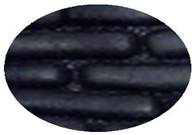 | Palm is made of 5 mm CHLOROPRENE RUBBER. |
| 2 | 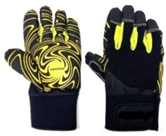 |  | Palm is made of CHLOROPRENE RUBBER. A 6 mm anti-vibration thicken pad provides protection against vibration. |
| 3 | 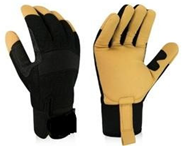 | 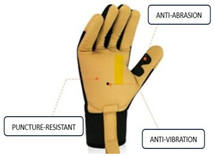 | There is an 8 mm special anti-vibration pad in the area extending from the palm to the fingertips. |
| 4 |  | 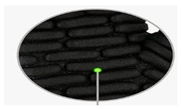 | A 7 mm FOAM LATEX RUBBER coating on the palm reduces impacts, shocks, and vibrations. |
| 5 | 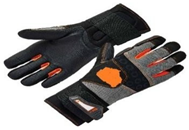 | 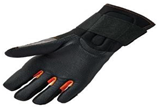 | A 7 mm full-length palm padding (35% POLYURETHANE) reduces vibration and palm impact. |
| 6 | 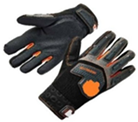 | 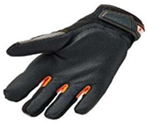 | An 8 mm full-length palm padding (29% POLYURETHANE) reduces vibration and palm impact. |
| 7 | 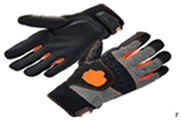 | 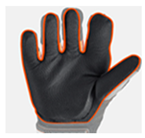 | A 6 mm full-length palm padding (37% POLYURETHANE) reduces vibration and palm impact. |
| 8 | 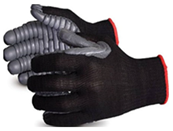 | 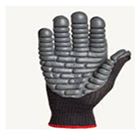 | A 5 mm vibration damping layer is coated with a POLYMER. |
| 9 | 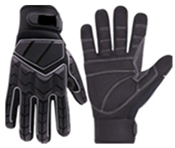 | 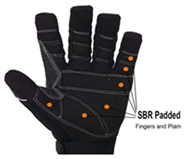 | There is a 5 mm SBR FILLER (Rubber Filler) on each finger and palm. |
| 10 | 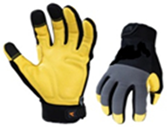 |  | There is 2.5 mm CHLOROPRENE (NEOPRENE) padding in the palm. |
| 11 |  | 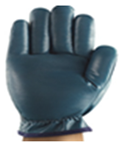 | There is soft 6 mm GEL FOAM padding in the thumb, index finger, and palm area. |
| 12 | 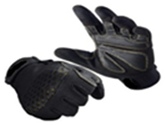 |  | The palm is covered with 3 mm of LATEX FOAM. |
Within the scope of this study, the hand–arm vibration exposure of the jackhammer operators working in 3 different mines (A, B, and C) was measured 3 times with and without gloves (Figure 3). Chrome is produced in mine A, and lead and zinc are produced in mines B and C. The working time of the operators was taken as 8 h. The averages of the vibration measurement results were used for comparison (Table 3).
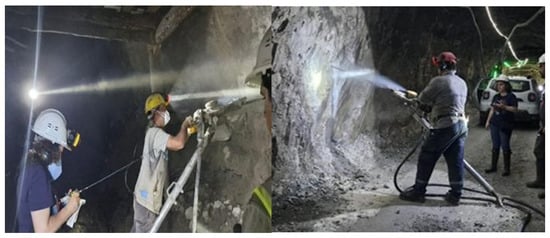
Figure 3.
Hand–arm vibration exposure measurements performed in the field.

Table 3.
Results obtained from mines A, B, and C.
Additionally, hand–arm vibration exposure measurements were conducted 3 times with and without gloves using a RETSCH brand, AS 200 model vibrating sieve set producing vibration at a certain frequency in the Mineral Processing Laboratory of the Mining Engineering Department (Figure 4). AS 200 devices operate at their natural frequencies, meaning the vibration frequency of the device is independent of the power frequency. AS 200 offers a digitally adjustable amplitude range of 0–3 mm. AS 200 models operate with a 3D throwing motion, which ensures even distribution of the sample across the sieve surface, thereby achieving high separation efficiency.
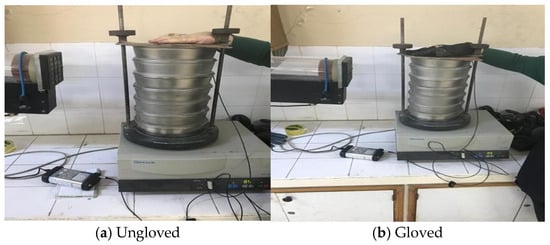
Figure 4.
Hand–arm vibration exposure measurements performed in a laboratory environment.
The vibration exposure measurement was conducted by applying hand pressure onto the sieve set. The averages of the measurement results were used for comparison.
3. Results and Discussion
3.1. Results of Field Measurements
Hand–arm vibration exposures of jackhammer operators working in 3 different mines (A, B, and C) were measured 3 times with and without gloves, and the average values were compared. Overall, the vibration damping rates (%) of 12 different anti-vibration gloves used in each of the 3 mines were calculated. Vibration damping rate (%) is determined using Equation (3).
A(8)ungloved: Daily personal vibration exposure measured without wearing gloves (m/s2).
A(8)gloved: Daily personal vibration exposure measured with wearing gloves daily (m/s2).
Ultimately, glove No. 1 exhibited the highest damping rate, and glove No. 12 exhibited the lowest damping rate (Table 3).
Oddo [10] found the exposure level to frequency-weighted hand–arm vibration in the frequency range of 6.3–1250 Hz to be 25 m/s2 when a jackhammer was operated in mining conditions. Nyantumbu et al. [8] reported that vibration acceleration levels as high as 31 m/s2 were measured for pneumatic hammers and jackhammers operated at a gold mine in the Republic of South Africa. Herein, the hand–arm vibration exposure level of the jackhammer was 20.95 m/s2 at mine A, 14.11 m/s2 at mine B, and 14.36 m/s2 at mine C.
Figure 5 shows the vibration exposure values of the jackhammer operators in mines A, B, and C, measured without gloves. The ungloved vibration exposure was higher in mine A than in mines B and C. The ungloved vibration exposure values may be similar at mines B and C because the same type of mineral (lead-zinc) is produced.
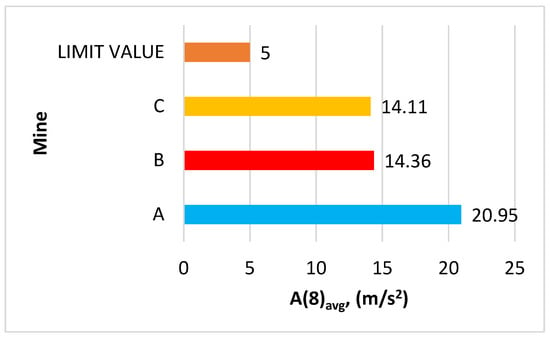
Figure 5.
Hand–arm vibration exposure values measured in the field without gloves.
The Regulation on Occupational Health and Safety in Mining Workplaces includes guidelines for the “Regulation on the Protection of Employees from Vibration-Related Risks”, which should be consulted to reduce employees’ exposure to vibration. In the regulation guidelines, the daily exposure limit and exposure action values are 1.15 m/s2 and 0.5 m/s2 for whole-body vibration and 5 m/s2 and 2.5 m/s2 for hand–arm vibration [20]. According to the vibration exposure measurements conducted in the field without gloves, the vibration exceeds the limit values specified in the regulation at all 3 mines (Figure 5).
Figure 6 shows the vibration exposure values obtained for jackhammer operators using 12 different gloves at mines A, B, and C. For all gloves and all mines, the vibration exposure exceeds the limit values specified in the regulations. This is consistent with the observations reported by Arıtan and Tümer [4], who showed that the hand–arm vibration was decreased in operators who used anti-vibration gloves but could not be reduced to the limit value specified in the regulations.
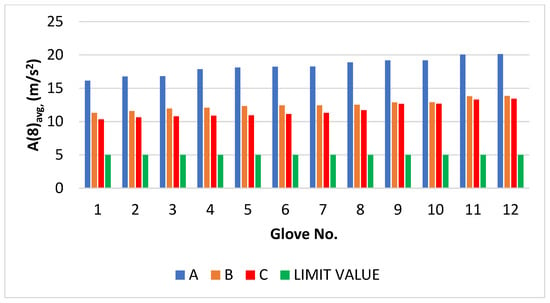
Figure 6.
Hand–arm vibration exposure values measured in the field using 12 different gloves.
3.2. Results of Laboratory Measurements
Hand–arm vibration exposure was measured 3 times, with and without gloves, using a fixed vibrating sieve set in the Mining Engineering Mineral Processing Laboratory. The average values of the measurement results were considered for comparison. The hand–arm vibration exposure value measured without gloves was determined to be 0.74 m/s2, and the values measured while wearing 12 different anti-vibration gloves are shown in Table 4, along with their vibration damping rates (%).

Table 4.
Results obtained in a laboratory environment.
To visualize the resulted listed in Table 4, Figure 7 shows a bar graph of the vibration damping rates (%) for the 12 gloves. Accordingly, the highest vibration damping rate is observed for glove No. 1 (44.59%), and the lowest vibration damping rate (%) is observed for glove No. 12 (22.97%).
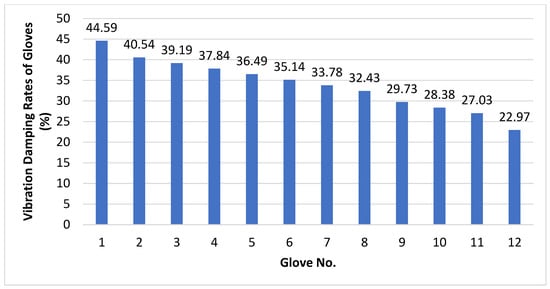
Figure 7.
Vibration damping ratios determined from laboratory measurements for the 12 gloves.
The vibration damping rates of the gloves observed in the laboratory environment were higher than those observed in the field environment. This difference is thought to result from different vibration spectra, standardized contact conditions in the laboratory, and varying grip patterns in the field.
The properties of the material used in a glove affect the transmissibility of vibrations through the material to the palm of the hand [21,22].
Chloroprene (Neoprene) is a type of synthetic rubber known for its chemical resistance, flexibility, and thermal stability. Chloroprene rubber is commonly used in anti-vibration gloves, typically as an inserted padding or surface coating. Its texture is generally firmer and more durable, and it may be slightly thicker. Latex Foam, a foam material derived from natural rubber obtained from rubber trees, is characterized by its softness, high elasticity, and flexibility, making it suitable for comfort-focused applications. It is especially used as a palm coating in gloves because it is both flexible and has vibration damping properties. Its texture is softer, spongy, and flexible. However, its chemical resistance is lower compared to chloroprene. This situation may help explain the difference in vibration damping rates between glove No. 1 and glove No. 12.
3.3. Statistical Evaluation of the Measurement Results
One-way ANOVA was performed to determine the differences in the vibration damping ratios among the 12 different gloves. The analysis was performed using SPSS 22 software. Before performing ANOVA, normality tests were conducted in the first stage to determine whether the data showed a normal distribution. From Table 5, the skewness value is 0.02, and the kurtosis value is −1.02. These values are in the range of −1.50 and +1.5, showing a normal distribution.

Table 5.
Descriptive statistics of the vibration damping ratios.
After dividing the skewness and kurtosis values by the standard error, the values of 0.06 and 1.33. are obtained, which are between −1.96 and + 1.96, following the normal distribution. Figure 8 shows that the histogram resembles the bell curve for a theoretical (Sample Mean: 14.34 and SD: 6.662) normal distribution.
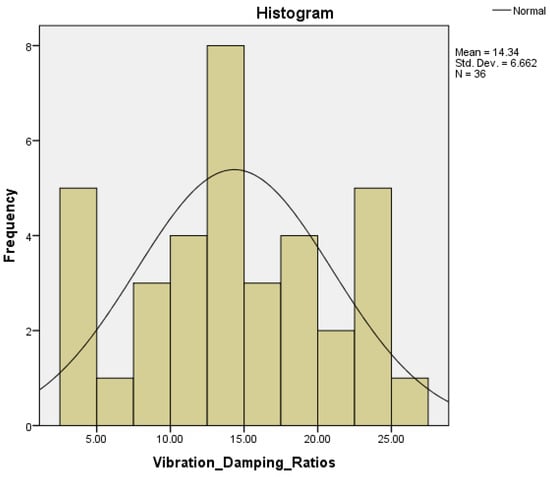
Figure 8.
Histogram of the data.
Table 6 shows the normality test results; the p-value of the Kolmogorov–Smirnov test results is greater than 0.05, indicating that the data are normally distributed.

Table 6.
Test of normality.
After confirming that the data showed a normal distribution, a one-way ANOVA was performed. This analysis is used in cases where a variable is measured in more than two independent studies to determine whether the results of these groups significantly differ. In this study, it was necessary to determine whether the vibration damping rates determined among the 12 different gloves were significantly different. The dependent variable is the vibration damping rate, and the independent variables are the 12 different gloves.
Table 7 shows the average vibration damping ratios, standard deviation values, and highest and lowest values of 12 different gloves. Table 8 shows the homogeneity test results for the variance among the vibration damping ratios. Given that the p-value in the table is less than 0.05, there is no homogeneity of the variance according to the arithmetic mean.

Table 7.
Descriptive statistics of the vibration damping ratios obtained for 12 different gloves.

Table 8.
Homogeneity of the variance.
Note that the condition of homogeneity was not met, and thus the Welch test result was considered instead of the ANOVA results. In Table 9, the p-value is less than 0.05, indicating that there are significant differences.

Table 9.
Welch test results.
Figure 9 shows the vibration damping rates of each glove according to the arithmetic mean. As a result, the highest average vibration damping rate is seen for glove No. 1; and the lowest average vibration damping rate is seen for glove No. 12.
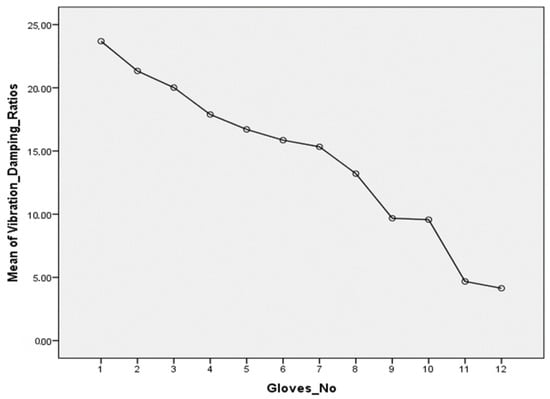
Figure 9.
Vibration damping ratio of each glove according to the arithmetic mean.
Finally, a post hoc analysis (multiple comparisons) was performed to determine which vibration damping ratios were significantly different. Because the variance was not distributed homogeneously, the Games–Howell test was used here.
As specified in Table 10, the p-values are ≤0.05 for several relationships. This indicates that there are significant differences between the vibration damping ratio of glove No. 1 and the vibration damping ratios of gloves Nos. 9, 10, 11, and 12; between the vibration damping ratio of glove No. 2 and the vibration damping ratios of gloves Nos. 11 and 12; between the vibration damping ratio of glove No. 9 and the vibration damping ratios of gloves Nos. 1, 11, and 12; between the vibration damping ratio of glove No. 10 and the vibration damping ratios of glove Nos. 1, 11, and 12; between the vibration damping ratio of glove No. 11 and the vibration damping ratios of glove Nos. 1, 2, and 10; and between the vibration damping ratio of glove No. 12 and the vibration damping ratios of glove Nos. 1, 2, 9, and 10.

Table 10.
Post hoc analysis results (multiple comparisons, Games–Howell test).
The p-values are ≥0.05 for some relationships in Table 10. This indicates that there are not significant differences between the vibration damping ratio of glove No. 1 and the vibration damping ratio of glove No. 2.
4. Conclusions and Recommendations
Vibration is a major problem for mining machine operators, resulting in health problems, and the mining machine with the most intense vibration is the jackhammer. In this study, 12 different anti-vibration gloves made of different materials were examined to determine the features that help reduce the hand–arm vibration exposure of jackhammer operators.
The hand–arm vibration exposure of jackhammer operators working in three different mines (A, B, and C) was first measured without gloves. From the field results, the vibration values exceeded the limit value specified in the regulations at all three mines and for all 12 gloves. Then, the hand–arm vibration exposure of jackhammer operators working in three different mines (A, B, and C) was measured with 12 different anti-vibration gloves, and the vibration damping rates (%) of 12 different anti-vibration gloves used in three different mines were calculated. At Mine A, the highest vibration damping rate was observed for glove No. 1 (22.96%), and the lowest damping rate was observed for glove No. 12 (3.91%); at Mine B, the highest vibration damping rate was observed for glove No. 1 (21.91%), and the lowest damping rate was observed for glove No. 12 (3.62%); and at Mine C, the highest vibration damping rate was observed for glove No. 1 (26.79%), and the lowest damping rate was observed for glove No. 12 (4.89%). Glove No. 1 is coated with chloroprene rubber, and the palm of glove No. 12 is coated with latex foam. Chloroprene (Neoprene) is a type of synthetic rubber known for its chemical resistance, flexibility, and thermal stability. Its texture is generally firmer and more durable. Latex Foam, on the other hand, is a foam material derived from natural rubber obtained from rubber trees. Its texture is softer, spongy, and flexible. The chemical resistance of latex foam is lower compared to chloroprene. This may help explain the difference in vibration damping rates between gloves No. 1 and No. 12.
Moreover, hand–arm vibration exposure measurements were carried out with and without gloves using a fixed vibrating sieve set in the Mining Engineering Mineral Processing Laboratory located in Adana, Turkey. Similarly, the highest vibration damping rate was observed for glove No. 1 (44.59%), and the lowest vibration damping rate was observed for glove No. 12 (22.97%). Thus, glove No. 1 has the features that provide the most effective vibration protection.
The vibration attenuation rates of the gloves, as measured under controlled laboratory conditions, were found to be higher than those recorded in field environments. This discrepancy is likely attributable to variations in vibration spectra, the standardized and repeatable contact conditions in laboratory settings, and the inconsistent grip forces and hand postures typically encountered during field operations.
Specifically, glove No. 1 was coated with chloroprene rubber, whereas glove No. 12 was coated with latex foam. Glove Nos. 3 and 4 also utilized latex foam, but the differences in thickness, surface area, or density may have been more favorable for vibration damping, compared with glove No. 12. Likewise, Glove No. 2 contained a coating of chloroprene rubber, but glove No. 1 showed slightly higher performance, although the difference was not significant (Table 10).
One-way ANOVA was performed to determine the differences among the average vibration damping ratios obtained for the 12 different gloves. The gloves were correlated with the differences in vibration damping ratios. Post hoc analysis (multiple comparisons) was performed to determine which vibration damping ratios were significantly different among the 12 gloves. There were significant differences between the vibration damping ratio of glove No. 1 and the vibration damping ratios of gloves Nos. 9, 10, 11, and 12; between the vibration damping ratio of glove No. 2 and the vibration damping ratios of gloves Nos. 11 and 12; between the vibration damping ratio of glove No. 9 and the vibration damping ratios of gloves Nos. 1, 11, and 12; between the vibration damping ratio of glove No. 10 and the vibration damping ratios of glove Nos. 1, 11, and 12; between the vibration damping ratio of glove No. 11 and the vibration damping ratios of glove Nos. 1, 2, and 10; and between the vibration damping ratio of glove No. 12 and the vibration damping ratios of glove Nos. 1, 2, 9, and 10.
Notably, for all gloves and mines studied herein, the hand–arm vibration that the jackhammer operators were exposed to was above the limit value specified in the regulation guidelines (5 m/s2). These findings underscore the need for vibration-absorbing systems. Ultimately, it is necessary to further reduce the vibration of the machines through modification and regular maintenance, including the improvement of personal protective equipment, such as gloves.
Operators should at least use gloves with the most effective damping properties. Gloves must be designed using materials with more effective damping properties and optimized features, such as the padding thickness and surface area. Detailed studies can also be conducted by correlating the hand–arm vibration exposure values of jackhammer operators working in different mining operations with other parameters of the machines, such as the operating frequency, power, and angle.
Within the scope of combating vibration, the working and rest periods of operators should be determined according to the exposure limit values, and the vibration exposure and health status of employees should be checked at regular intervals.
Employers must provide training to their employees, especially machine operators, to protect themselves from risks caused by vibration and to ensure that they comply with the vibration regulations. In this context, employers must conduct a risk assessment and frequently inspect their employees regarding the proper use of personal protective equipment.
Funding
This study was supported by Çukurova University (Project No.: FBA-2022-15044).
Institutional Review Board Statement
Ethical review and approval were waived for this study because it is a preliminary study conducted with a very limited number of workers based on their voluntary participation.
Informed Consent Statement
Informed consent was obtained from all participants involved in this study.
Data Availability Statement
The original contributions presented in this study are included in the article. Further inquiries can be directed to the author.
Conflicts of Interest
The author declares no conflicts of interest.
References
- Zeyrek, S. Vibration. Occupational Health and Safety. Specialization Thesis, Ministry of Labor and Social Security General Directorate of Occupational Health and Safety, Ankara, Turkey, 2009. Available online: https://www.csgb.gov.tr/Media/guon31qb/serapzeyrek.pdf (accessed on 2 June 2025).
- Fritz, M. Description of the Relationship Between the Forces Acting in the Lumbar Spine and Whole Body Vibrations By Means of Transfer Functions. Clin. Biomech. 2000, 15, 234–240. [Google Scholar] [CrossRef] [PubMed]
- Erdem, B.; Doğan, T.; Özgen, Z. Measurement and Evaluation of Hand-Arm Vibration Exposure Sourced From Some Power Tools in Mining Workplaces. Mining 2016, 55, 23–44. [Google Scholar]
- Arıtan, A.E.; Tümer, M. Investigation of Hand-Arm Vibration Exposure in the Use of Pneumatic Hammer in the Natural Stone Quarries. Çukurova Univ. J. Fac. Eng. Archit. 2018, 33, 57–66. [Google Scholar]
- Youakim, S. Hand-Arm Vibration Syndrome. BC Med. J. 2009, 51, 10. [Google Scholar]
- Xu, X.; Yuan, Z.; Gong, M.; He, L.; Wang, R.; Wang, J.; Yang, Q.; Wang, S. Occupational Hazards Survey Among Coal Workers Using Hand-Held Vibrating Tools in a Northern China Coal Mine. Int. J. Ind. Ergon. 2017, 62, 21–26. [Google Scholar] [CrossRef]
- Arıtan, A.E.; Memiş, Z. Investigation of Vibration Exposure of Natural Stone Operators Working in The Field. In Proceedings of the International Symposium on Occupational Health and Safety in Mining 2019, Adana, Turkey, October 3–4 2019; pp. 485–492. [Google Scholar]
- Nyantumbu, B.; Barber, C.M.; Ross, M.; Curran, A.D.; Fishwick, D.; Dias, B.; Kgalamono, S.; Phillips, J.I. Hand–Arm Vibration Syndrome in South African Gold Miners. Occup. Med. 2006, 57, 25–29. [Google Scholar] [CrossRef] [PubMed]
- Erol, İ. Investigation of Noise and Vibration Exposure of Underground Coal Mining Machinery Operators. Çukurova Univ. J. Fac. Eng. Archit. 2022, 37, 55–65. [Google Scholar]
- Oddo, R.; Loyau, T.; Boileau, P.E.; Champoux, Y. Design of a Suspended Handle to Attenuate Rock Drill Hand-Arm Vibration: Model Development and Validation. J. Sound Vib. 2003, 275, 623–640. [Google Scholar] [CrossRef]
- Nor, A.A.; Mohd, I.G.; Musli, N.Y. Hand Arm Vibration and Personnel Noise Exposure Characteristics of Hand Held Grass Cutter Machines. In Proceedings of the 21st International Congress on Sound and Vibration, Beijing China, 13–17 July 2014; pp. 1–8. [Google Scholar]
- Brown, A.P. The Effects of Anti-Vibration Gloves On Vibration Induced Disorders: A Case Study. J. Hand Ther. 1990, 3, 94–100. [Google Scholar] [CrossRef]
- Jetzer, T.; Haydon, P.; Reynolds, D.D. Effective Intervention with Ergonomics, Antivibration Gloves, And Medical Surveillance To Minimize Hand-Arm Vibration Hazards in The Workplace. J. Occup. Environ. Med. 2003, 45, 1312–1317. [Google Scholar] [CrossRef] [PubMed]
- Dong, R.G.; McDowell, T.W.; Welcome, D.E.; Wu, J.Z.; Rakheja, S. Analysis of Anti-Vibration Gloves Mechanism and Evaluation Methods. J. Sound Vib. 2008, 321, 435–453. [Google Scholar] [CrossRef]
- ISO 10819; Mechanical Vibration and Shock—Hand–Arm Vibration—Measurement and Evaluation of the Vibration Transmissibility of Gloves at the Palm of the Hand. ISO: Geneva, Switzerland, 2013.
- SET Machine. Technical Specifications of Machines. 2025. Available online: https://www.setmakina.com/en/tigeryt24 (accessed on 2 June 2025).
- TS EN ISO 5349-1; Turkish Standards, Mechanical Vibration–Measurement and Evaluation of Hand-Transmitted Vibration to Which Persons Are Exposed–Part 1: General Rules. TSE: Ankara, Turkey, 2005.
- TS EN ISO 5349-2; Turkish Standards, Mechanical Vibration—Measurement and Evaluation of Human Exposure to Hand-Transmitted Vibration—Part 2: Practical Guidance for Measurement at the Workplace. TSE: Ankara, Turkey, 2015.
- Amazon.de. 2024. Available online: https://www.amazon.de/s?k=anti+vibRAT%C4%B0ON+GLOVES (accessed on 2 June 2025).
- TUR-2013-R-107868; Regulation on the Protection of Workers from Vibration-Related Risk. Ministry of Labor and Social Security (MLSS): Ankara, Turkey, 2013.
- O’Boyle, M.; Griffin, M.J. Predicting the Effects of Push Force on the Transmission of Vibration Through Glove Materials to the Palm of the Hand. In Proceedings of the 10th International Conference on Hand-Arm Vibration, Las Vegas, NV, USA, 7–11 June 2004. [Google Scholar]
- Laszlo, H.E.; Griffin, M.J. The Transmission of Vibration Through Gloves: Effects of Push Force, Vibration Magnitude and Inter-Subject Variability. Ergonomics 2011, 54, 488–496. [Google Scholar] [CrossRef] [PubMed]
Disclaimer/Publisher’s Note: The statements, opinions and data contained in all publications are solely those of the individual author(s) and contributor(s) and not of MDPI and/or the editor(s). MDPI and/or the editor(s) disclaim responsibility for any injury to people or property resulting from any ideas, methods, instructions or products referred to in the content. |
© 2025 by the author. Licensee MDPI, Basel, Switzerland. This article is an open access article distributed under the terms and conditions of the Creative Commons Attribution (CC BY) license (https://creativecommons.org/licenses/by/4.0/).